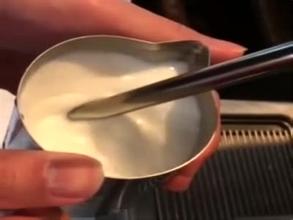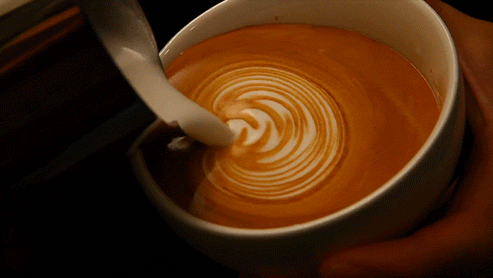Changes in the roasting of coffee beans: why do coffee beans turn brown after baking? Why is there an aroma?
Factors of coffee color change:
Coffee beans are light green and turn brown when roasted. This baking characteristic brown mainly comes from the brown pigment produced by oligosaccharins, amino acids and chlorogenic acids. The so-called brown pigment does not refer to a color or ingredient, but a general term for the many ingredients that make coffee different colors.
The color of raw beans changes gradually during baking because of the change in the total amount of brown pigment and the proportion of its molecular size. Brown pigments can be classified according to molecular size. Shallow baking will mostly produce small molecular pigments. With the deeper the baking degree, the total amount of pigments will gradually increase, and the proportion of macromolecular pigments will also increase.
Light baked beans mostly contain small yellowish pigments, which are chemical reaction products in the early stage of baking and substances produced by the reaction between oligosaccharides and chlorogenic acids.
If you continue baking, the oligosaccharides will be caramelized to produce caramel pigments. Coupled with the molasses pigment (Melanoidin) produced by the reaction of oligosaccharides with amino acids, a slightly larger reddish brown pigment occurs. The reaction produced by molasses pigment is called Mena browning reaction (Maillard reactions), which is a very important kind of food chemical reaction. The color and flavor of toast and the color of soy sauce are all the result of Mena's browning reaction.
If you continue to bake, proteins and polysaccharides are also added to turn into a black-brown pigment with more than a hundred times the size of the molecule.
This pigment is actually one of the elements that make up the bitterness of coffee. It is generally believed that the larger the molecule of the pigment, the stronger the bitterness of the coffee and the heavier the taste. Therefore, the intensity and taste of bitterness will change with the degree of roasting of coffee, which is affected by these pigment changes.
The reason for the aroma of coffee:
Coffee raw bean moon has two hundred aroma components, but those aromas are not comfortable for us. What makes the aroma of coffee attractive is the baptism of roasting and the many aroma components produced by roasting (there are 700 known ingredients alone). Compared with the ingredients that make up the taste of coffee, although the components of each aroma are small, they have a great impact, and they can even be said to be the main ingredients of coffee.
The last part mentioned that coffee roasting produces Mena browning reaction, which also plays an important role in the formation of coffee aroma. Flavor increase, soy sauce, or barbecue, bread have a unique aroma, these are the secondary results of Mena browning reaction. So is the aroma of coffee. What kind of aroma can be played to what extent depends on the arrangement and combination of amino acids and heating conditions. Coffee contains a variety of amino acids, but the arrangement and combination of amino acids is affected by varieties, planting conditions, delicate methods and so on, so different raw beans have different aroma. In addition, even if the same raw beans are used, the increase in temperature and roasting degree of roasted coffee beans will also change the aroma.
The caramelization mentioned in the previous section is also one of the chemical reactions that create the aroma of coffee. When caramel is produced, it will emit volatile acid, and its aroma and sweet aroma are important elements of coffee aroma. Other substances such as chlorogenic acid will also produce aroma when heated.
Baking produces many aroma components that vary depending on the degree of baking. The changed patterns can be roughly divided into three categories: 1. A substance with less change; 2. A substance that begins to decrease after increasing to a certain extent; 3. A substance that increases gradually during baking. 1. It is mostly regarded as the ingredient in raw beans; 3. It is usually considered to be a smoky or pungent ingredient; 2. For us, it is an ingredient that brings comfortable sweet and sour aromas or baked sweet aromas. The reason why different baking degree can change the texture and intensity of the aroma is due to the change of the total amount and balance of the above three aroma components.
Reference book "Scientific interpretation of the Secrets of Coffee"
Important Notice :
前街咖啡 FrontStreet Coffee has moved to new addredd:
FrontStreet Coffee Address: 315,Donghua East Road,GuangZhou
Tel:020 38364473
- Prev

Italian Coffee making course: detailed explanation and Correction of the problem of Milk bubbling
Prepare knowledge to understand the correct operation process of the coffee machine steam system, understand the purpose of empty steam pipes before and after foam, and understand the importance of towels and handy cleaning in coffee making. Learn how to use the sprinkler to touch the milk noodles, the location and depth of the selected points. There are two temperature problems, one is the starting and ending temperature of foaming, and the other is the temperature at which the foam is made. These two.
- Next

A course in making espresso: an introduction to the technical skills and the use of specific tools
Coffee latte-art is a change made on the original cappuccino or latte. As a matter of fact, there has never been a very clear literature on the origin of coffee flowers. We only know that in Europe and the United States, coffee flowers showed difficult professional skills during coffee performances, and such innovative skills, the difficult technology displayed, greatly shocked the coffee at that time.
Related
- What is the meaning of lactic acid fermentation with coffee bean treatment?
- How to judge the state of foam by sound?
- How does the latte pull out the unicorn pattern? Come to get for a little trick to improve the flower pull!
- Will flower pulling affect the taste of the latte?
- Do you know the history of coffee?
- The difference between honey treatment and sun washing what is raisin honey treatment?
- What kind of milk can a novice use to make coffee foam to keep the foam longer? The correct method and skills of milking tutorial sharing
- Why do washed coffee beans taste sour? Flavor characteristics of washed Coffee
- Introduction to the skill of how to practice the size and height of water injection around the circle of hand-brewed coffee
- How do beginners practice coffee flower drawing from scratch?

